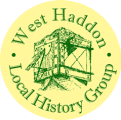Mills and Markets
In the Middle Ages most people in West Haddon would have spent most of their time working the land and raising food. Compared with modern methods farming was very inefficient and surpluses were few. Any business transactions were more likely to be conducted in kind than cash.
In the centuries after the Norman Conquest there were several ways a lanlord could raise income from the village. Firstly, simply by collecting rents from all the tenants. Secondly, by building a mill and obliging everyone to take their corn to be ground there. The miller kept a proportion of the grain brought to hi by way of a fee, and the landlord in his turn took a cut from the miller. Thirdly, a landlord could set up a market in the village, provided that there were no rival markets too close. This market would provide a focus for a number of neighbouring villages for the exchange of any surplus produce and various specialist manufacturers. It also became a stopping off place for merchants and travellers from further afield. The landlord would levy a toll on everyone using the market.
Unfortunately we do not know when West Haddon market began, but we do know that Northampton complained that West Haddon had a market which was affecting trade in the County Town in 1275. A market charter was granted to Daventry Priory (West Haddonís landlord) in 1292 to change the day to Thursday (we donít know what it was before). The County Historian, Mr Bridges, noticed that it was still going in the 1720ís albeit on a rather small scale, but still on a Thursday. IN the nineteenth century, Underwoods, an old village family, were running regular cattle markets and other auctions in the village. These were held in Market Field at the western end of the village at the rear of Thorndale House.
We find West Haddonís mills mentioned in a variety of old deeds and records. The first reference to a windmill is a record of a burglary there in 1334!
Property deeds of the time of Queen Elizabeth I show that West Haddon then had both a wind and water mill. Bridges describes the watermill as having been on the stream dividing West Haddon from Long Buckby, and there is still a field there called Mill Meadow.
At the time of the Enclosure Award in 1765 the windmill was at the top of the Winwick gated road (still known as Windmill Hill) but there was also a field called Mill Furlong somewhere close to Torkington farm, to the east of Northampton Road. Could it be that the mythical Oster Hill burial mound at Torkington is in fact an old abandoned mill site?
